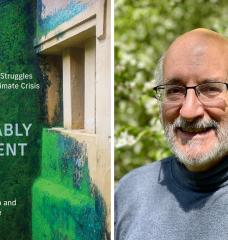
Dr. Patrick Brereton is an ecocinema scholar and professor at Dublin City University. His published works in include Hollywood Utopia: Ecology in Contemporary American Cinema, Continuum Guide to Media Education, and Historical Dictionary of Irish Cinema. We sat down with Professor Brereton to discuss climate change’s representation in ecocinema, and the role of media in larger environmental conversations.
Mikaela: Tell us a little bit about yourself. What inspired your path as an environmental film scholar?
Pat: I have always been into the environment – I come from a farming background from the midlands in Ireland. For my formative years I worked on our farm and enjoyed it a lot. I Worked in various jobs in Dublin and then did Arts degree as a mature student which I loved – but not so good for getting jobs.
In the last recession back in the 1980s, I emigrated with my wife to UK and ended up doing my PhD in Film study, focused on film and environmentalism [see my book Hollywood Utopia: Ecology in Contemporary American Cinema (2005)]. This was where I began my fixation with eco-cinema. We moved back home to Ireland in 2001,where I have worked in Dublin City University (DCU) ever since – and have developed my eco-media research.
Mikaela: Pat, you’re known for your work in “ecocinema”. Can you explain what that is?
Pat: Ecocinema draws on the growth of environmental literature; which foregrounds the importance of landscape and how to protect the environment. A small number of media and film scholars, including myself, began to argue that film (not just explicitly environmentally focused storylines) could in many ways help to promote new ways of reflecting/speaking about the environment.
Environmental literacy and education is certainly not simply a top-down process of disseminating correct attitudes, values, and beliefs, but alternatively incorporates and facilitates a dialogue with audiences of different persuasions and at all levels of knowledge and engagement, to help highlight and at best co-produce consensual solutions to the major challenges of our time.
Mikaela: How is climate change represented in ecocinema?
Pat: By any measure, there remains a lack of environmentalism being registered or even tangentially evident across the global communications political sphere. Certainly, this is a major shortcoming and signals the abiding need for creatives and environmental activists to proactively assist in developing more explicit and effective audio-visual media projects, which cogently speak to the apocalyptic climate change situation.
Climate change has become the bellwether debate which encapsulates many environmental debates and is often characterized as a ‘wicked problem’ which is very difficult to address – much less fully comprehend the implications. Some of these films (from Avatar to Day after Tomorrow) can be decoded as representing an eco-centric (pro-environmental) worldview that among other aspects, recognizes the intrinsic value of nature (i.e. anti-anthropocentrism), the fragility of nature’s balance, limits to economic growth, and most importantly the possibility of future ecological crisis.
Mikaela: What are some mainstream examples of ecocinema, or films with ecocinema elements?
Pat: The scope and engagement and empathetic engagement activated by fictional narratives can have a major effect in ‘speaking to mass audiences’ who might not be directly open to such ‘heavy environmental thinking’. Often such allegorical narratives connect below the radar of education and through entertainment. Films with eco-cinematic readings include:
- Blade Runner: Foregrounds a dystopian, post-climate change future.
- Jurassic Park: A cautionary tale around “messing with nature/science”.
- Gravity: An allegory exploring ideas of waste and consumption.
- The Hunger Games: An allegory of totalitarianism versus “nature”.
Mikaela: Does fiction give people space to process large-scale like climate change in a meaningful way?
Pat: Certainly audio-visual fictional (and even some documentary/non-fiction) can show how ‘everything is connected’,which lots of environmental journalism finds it hard to get across to mass audiences. Often such films as The Day after Tomorrow, Avatar and WALL-E are accused of simplifying the environmental science – which of course they do. But I would argue if they keep the debate in the public sphere then they are doing a good job. Audiences of course need to source information and knowledge from a variety of media – from films, to YouTube videos, to blogs, to detailed reports, to books and to journal articles.
Mikaela: How is narrative film a part of the larger dialogue surrounding climate change?
Pat: Art and media have major role in ‘framing the issues’ – providing ‘provocative narrative strategies’ to call attention to the issues. This is key, since so many in the general population are not engaged with climate change issues. We need more ‘creative imaginaries’ to keep the agenda directly if not indirectly in the public consciousness.
Furthermore, it is affirmed that environmental education is not simply about ‘saving the whale’ or indeed saving local habitat’s but is equally about the development of an appreciation of the wonders and beauty of the world and provoking a sense of wanting to save it.
Climate communicators most certainly above all else should appeal to values held by their target audience to make it easier for audience members to recognize climate change as a personally meaningful issue.






